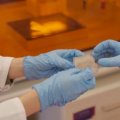UQ archaeologists have found remnants of a school and a strong presence of women and family life at one of Queensland’s most significant historical villages.
Pieces of writing slates and ceramic ink wells as well as sewing needles, decorative buttons, jewellery, perfume bottles, ceramic doll hands and feet and parts of a concertina or harmonica have been unearthed
from the Mill Point Archaeological Site, north of Noosa Heads.
The frontier settlement based around Lake Cootharaba in the southern end of the Great Sandy National Park, was home to several hundred people and one of Queensland’s first sawmills from 1869 to 1892.
Dig leaders UQ PhD archaeology students Stephen Nichols and Karen Murphy said the new artefacts challenged its traditional, masculine history.
“Most of the written history is all about the men logging timber and working in the mill, but we know there were lots of women and children in the community here as well,” Ms Murphy said.
Ms Murphy, 37, of Paddington, who is researching 19th century family life at Mill Point, said she believed more than half the population were women and children.
She said the frontier settlement was a self -contained community with a substantial school found south of the mill, a library, shop and stores as good as anything else in the Noosa district at the time.
Mr Nichols said the settlement was still plugged into a global trade network with access to supplies such as alcohol, perfume and foodstuffs from all over the world.
He is using the Mill Point dig to examine community attitudes to Australia’s past.
“There’s a great interest in Australia’s past but very little knowledge and opportunity to engage with it,” Mr Nichols said.
“Most people’s ideas are constructed in an old 1950s pioneer narrative of the past.”
Mr Nichols, 42, from Clayfield, said there were still many archaeological discoveries to be made on the five-square-kilometre site.
He said there were plans to use radar to pinpoint graves in the Mill cemetery and more potential for maritime archaeology, Aboriginal history and the history of consumerism.
The Mill Point Archaeological Project was a recent joint winner of the Australasian Society for Historical Archaeology’s award for the Martin Davies Award for Best Public Archaeology Initiative.
Mr Nichols said Mill Point shared the award with iconic Port Arthur in Tasmania which had more resources and staff.
He said Mill Point was unique because it was within a national park, not built over and because the general public could volunteer to do valuable archaeological fieldwork.
A chimney, boiler, piles of bricks and cemetery are the only visible remains on the site now.
More than 10,000 artefacts from brick fragments to doll hands, have been uncovered so far.
Mr Nichols and Ms Murphy are both Australian Postgraduate Awards scholarship recipients and hope to finish their PhDs next year.
MEDIA: Mr Nichols (0422 075 639, s.nichols@uq.edu.au), Ms Murphy (0401 644 678, k.murphy2@uq.edu.au), or Miguel Holland at UQ Communications (3365 2619)
.jpg)



